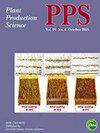Effect of flood and drip irrigation and difference of previous crop residue input on morphological and physiological traits in rice root
IF 1.3
3区 农林科学
Q2 AGRONOMY
引用次数: 0
Abstract
ABSTRACT Detailed information on the root system under drip irrigation will help in more efficient irrigation scheduling. Although input of previous crop residues is effective in increasing soil fertility, little is known about its effect on the root system. This study aimed to investigate the effects of irrigation methods (drip or flood) and different management of previous crop residues on root morphological characteristics and its distribution and physiological functions of the rice cultivar ‘Hinohikari’. Experiments were conducted in the paddy field on the university farm (input previous crop residues every year) for both drip and flood irrigation and the paddy and upland field (no input previous crop residues) on the campus of the faculty under flood and drip irrigation. Plant root was sampled with a core sampler (ø 5.5 cm × 30 cm), and root length and surface area were determined using image analysis. Drip irrigation did not change root length compared to flood irrigation, but the root system was heavier and individual root thickness tended to increase compared to flood irrigation. The root depth index was significantly deeper in drip irrigation than in flood irrigation. The bleeding rates were significantly higher in flood irrigation than in drip irrigation. Applying previous crop residues significantly improve root length mainly at the upper soil layers. The mechanisms for enhancing root growth by applying previous crop residues need to be explored individually in flood and drip irrigation, in which physical and chemical properties in soil are largely different. Graphical Abstract水灌和滴灌及前茬作物秸秆输入量差异对水稻根系形态生理性状的影响
滴灌条件下根系的详细信息将有助于更有效的灌溉调度。虽然以前作物残茬的投入对提高土壤肥力是有效的,但对其对根系的影响知之甚少。研究了不同灌溉方式(滴灌、淹灌)和不同残茬处理方式对“日光”水稻根系形态特征及其分布和生理功能的影响。实验在大学农场的水田(每年投入前茬作物残留物)进行滴灌和漫灌,在学院校园的水田和旱田(不投入前茬作物残留物)进行漫灌和滴灌。采用ø 5.5 cm × 30 cm的芯样器对植物根系进行采样,通过图像分析确定根系长度和表面积。与漫灌相比,滴灌对根系长度没有影响,但根系较重,单根粗细有增加的趋势。滴灌处理的根深指数显著高于漫灌处理。漫灌的出血率显著高于滴灌。施用前茬作物残茬显著提高根系长度,主要在上层土壤。在土壤物理和化学性质有很大差异的洪涝和滴灌条件下,利用前茬作物残茬促进根系生长的机制需要分别探索。图形抽象
本文章由计算机程序翻译,如有差异,请以英文原文为准。
求助全文
约1分钟内获得全文
求助全文
来源期刊

Plant Production Science
农林科学-农艺学
CiteScore
5.10
自引率
4.00%
发文量
27
审稿时长
>36 weeks
期刊介绍:
Plant Production Science publishes original research reports on field crops and resource plants, their production and related subjects, covering a wide range of sciences; physiology, biotechnology, morphology, ecology, cropping system, production technology and post harvest management. Studies on plant production with special attention to resource management and the environment are also welcome. Field surveys on cropping or farming system are also accepted. Articles with a background in other research areas such as soil science, meteorology, biometry, product process and plant protection will be accepted as long as they are significantly related to plant production.
 求助内容:
求助内容: 应助结果提醒方式:
应助结果提醒方式:


